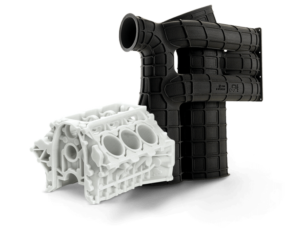The aerospace industry has always been at the forefront of technological innovation, and the introduction of 3D printing (also known as additive manufacturing) has paved the way for revolutionary changes in how we think about aircraft design, space exploration, and much more. This blog post explores the impact of 3D printing in aerospace, highlighting how it’s leading the charge in solving complex issues and manufacturing highly specialized parts.
The Power of Additive Manufacturing in Aerospace
From custom brackets in airplanes to intricate parts for satellites, the potential of 3D printing is boundless, especially regarding the unique demands of the aerospace sector. Traditional manufacturing methods, such as machining and casting, are often limited by the complexity of the parts they can produce and the time it takes. 3D printing offers a new avenue, allowing for customization, complexity, and speed that was previously unimaginable.
Customization and Complexity
Aircraft systems are incredibly complex, often requiring parts designed for a specific model or even an individual aircraft. 3D printing empowers designers to create parts with complex geometries, including internal channels and lattice structures, that optimize performance and reduce weight.
Rapid Prototyping
A key advantage of 3D printing in aerospace is the ability to prototype new designs rapidly. The iterative process of testing and refining parts is accelerated, leading to faster innovation and improved products.
Addressing Aerospace Challenges with Additive Manufacturing
The aerospace industry faces unique challenges, from extreme operating conditions to stringent safety regulations. 3D printing is proving to be effective in addressing these challenges head-on.
- Material Innovation
Material innovation is one of the most critical areas where 3D printing is making a difference. Additive manufacturing allows for using advanced materials that are lighter and more durable, such as titanium and carbon composites, which are essential for maintaining structural integrity while reducing weight to improve fuel efficiency.
- On-Demand Manufacturing
The concept of warehouses stocked with spare parts is changing with 3D printing. Instead of carrying an extensive parts inventory, airlines, and manufacturers can print parts on-demand, reducing storage costs and ensuring parts are readily available when needed.
The Future of 3D Printing in Aerospace
As technology advances, so does the role of 3D printing in the aerospace industry. The future holds even more exciting prospects as 3D printing continues to evolve.
- In-Orbit Manufacturing
The ability to manufacture parts in space is a game-changer for long-duration missions and the construction of space-based infrastructure. 3D printing enables on-site production, reducing the reliance on Earth-based supply chains and the costs of transporting materials.
Multi-Material Printing
The next frontier for additive manufacturing is multi-material printing, which will allow for creating parts with a combination of materials in a single build. This capability will open new possibilities for creating products with enhanced functionalities and performance characteristics.
Supporting Aerospace Innovation with Prototyping Services
Aside from 3D printing, various other innovative production services support the aerospace technology revolution. Let’s explore these complementary processes that Quickparts offers.
CNC Machining
CNC machining remains a staple in the aerospace industry for its precision and ability to work with various materials. Quickparts offers volume solutions of both polymer and metal CNC machining. Combined with 3D printing, it offers a complementary approach to producing parts that require both the plasticity of additive manufacturing and the precision of subtractive methods.
Investment Casting
Die casting is crucial for creating parts with high geometric complexity and excellent surface finish, vital for many aerospace applications. Prototype investment casting plays a pivotal role in testing the manufacturability of a part before going into mass production.
SLA 3D Printing
Stereolithography (SLA) printing is a 3D printing process that works with photopolymer resins and a high-powered UV laser. In aerospace, SLA is often used for creating precise prototypes and parts that will undergo testing for form, fit, and function.
Urethane Casting (Vacuum Casting)
Urethane casting is a cost-effective method for producing low-volume parts with the same material properties as injection-molded plastics, ideal for early-stage prototypes and components used in the aerospace industry.
How to Choose the Right Prototyping Partner for Your Aerospace Project
Selecting the right prototyping partner for aerospace projects is critical to success. Here are the factors to consider when scouting for a prototype manufacturing service:
Experience and Expertise: Look for partners with a strong track record in aerospace prototyping and a deep understanding of industry regulations and best practices.
Advanced Machinery: The aerospace industry demands the highest standards of precision and quality. Prototyping and low volume partners should have state-of-the-art machinery and technology to meet these requirements.
Materials: Aerospace parts must withstand extreme temperatures, corrosive environments, and high stress. Ensure your partner has the material options that align with your project’s needs.
Production Speed: The ability to deliver prototypes quickly can be the difference between securing a valuable contract or missing an opportunity. Timely prototyping services are a must.
Cost: While not the sole determining factor, cost-effectiveness is important. A balance between quality and cost is key when selecting a production partner.
Final Thoughts: Embracing Change for a Thriving Aerospace Sector
The aerospace industry is emblematic of human innovation and the relentless pursuit of what’s possible. The sector is poised to achieve greater heights by integrating 3D printing and advanced prototyping techniques. By working with Quickparts and embracing new manufacturing methods, aerospace companies can stay ahead in an ever-evolving market, propelling themselves toward a future where the sky is no longer the limit.


